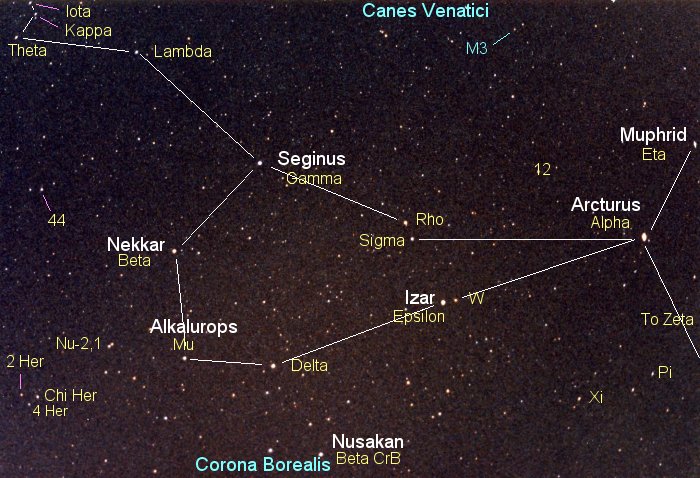geckzilla wrote:It's too bad that she couldn't state why Kaler would have used the word "white" in this instance, which he did not say was wrong, just confusing. It would have greatly helped the situation if it were stated something like "Oh, he wrote 'white' because of [explanation]. But visually, this star is blue." Instead of that, it was implied that it was written completely in error. Vindicated? I know several people think that I am attacking Ann but these things bother me quite a lot.
Good question, Geck. I have followed Jim Kaler quite closely for some years, although slightly less closely recently. I also own two of his books. In my opinion, Professor Kaler is not too interested in the B-V indexes of stars, nor even really of their visual appearances in the telescope, at least not when it comes to bluish stars. He goes straight for the spectral class and defines the color of the star from the spectral class. Therefore, a star of spectral class A is white to him. Similarly, a star of spectral class F is yellow-white and a star of spectral class G is yellow. He will normally call K-type stars orange and M-type stars red. O stars are blue to him, and B stars are blue-white.
Since Jim Kaler goes straight for the spectral class when he defines the color of a star,
he calls Canopus a yellow-white star:
Canopus, the much grander star, is vastly farther away and is a rather rare class "F" yellow- white (7280 Kelvin) bright giant.
However, Canopus is remarkably bluish for an F-type star. It is not
blue, of course, not so that it has a negative B-V index. But it has a remarkably "low" B-V index (for an F-type star) of about 0.15. That is clearly bluer than some A-type stars, for example Altair. (I don't have access to my software right now, but I'd say that the B-V index of Altair is about 0.27.) Yet
Jim Kaler calls Altair white:
Though three of the stars of the Summer Triangle are all white in color and hotter than the Sun, all are also individuals. A class A (A7) hydrogen-fusing dwarf with a temperature of 7550 degrees Kelvin, Altair is the coolest of the three (with Vega and Deneb warmer at 9500 and 8400 respectively).
To me, the really interesting question is why A-type stars are "defined" as white. (
See the link that Margarita sent.) My answer is that Vega has been used as the "perfect definition" of a white star, yet the visual appearance of Vega (through a telescope) is quite bluish. I have asked a number of people to look at Vega through a telescope and say what color it is. Everyone said that Vega looked blue.
In his book
A View of the Universe, David Malin offered an explanation for astronomy's reluctance to acknowledge the existence of blue stars. I'm summarizing David Malin's claims from memory here, since I don't have access to his book right now, but what he said is that astronomy since antiquity has defined stars as white, yellow or red. When astronomers began studying double stars through a telescope, they saw blue stars (for example the fainter component of Albireo), but because the blue stars were members of binaries they were regarded as a curiosity. The idea that (single) stars can indeed be blue visually was mostly rejected, if only because the idea was so unfamiliar. Personally I have to admit that hardly any stars ever look blue to me without visual aids like a telescope.
But let's assume that David Malin was right in his claim that astronomy mostly rejected the idea that stars can "really" be blue. The only possible star colors would then be white, yellow and red. If you want to define the whitest possible star (and you live in the northern hemisphere, like most astronomers have done since antiquity), you might well pick the star that looks as perfectly non-red as possible. To me, that might very will be Vega, if only because Vega is bright and doesn't twinkle like a disco ball, like Sirius. Of course, I think that Vega is definitely very bluish when seen through a telescope, but if it was out of the question to define Vega as blue, then it might instead become the most perfect example of stellar whiteness.
And if Vega is perfectly white, and if it is white because it is an A-type star, then it really doesn't matter what it looks like through a telescope. It is white because it is white, and then all other A-type stars can be defined as white, too. And then F-type stars are yellow-white, and G-type stars are yellow, and K-type stars are orange and M-type stars are red. Only O- and B-type are "allowed" to be bluish. For that reason, a star like Rigel is often defined as bluish or blue-white.
Jim Kaler defines Rigel, a B8-type supergiant, as blue or blue-white,, even though its B-V index is not all that impressive, around -0.03:
Like its class M reddish rival in Orion, Betelgeuse, Rigel (Beta Orionis) is a supergiant, though a contrasting blue one (actually more blue-white) of class B (B8).
So to summarize, I think that Jim Kaler simply defines the color of a star from its spectral class, although in a few cases he might underscore the actual color of them. That happens mostly when he talks about a few unusually red stars.
Ann


